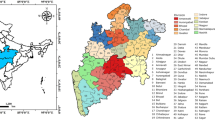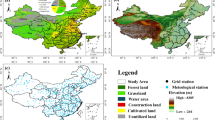Abstract
Drought is a natural disaster that significantly affects human life; therefore, precise monitoring and prediction is necessary to minimize drought damage. Conventional drought monitoring is based predominantly on ground observation stations; however, satellite imagery can be used to overcome the disadvantages of existing monitoring methods and has the advantage of monitoring wide areas. In this research, we assess the applicability of drought monitoring based on satellite imagery, focusing on historic droughts in 2001 and 2014, which caused major agricultural and hydrological issues in South Korea. To assess the applicability and accuracy of the drought index, drought impact areas in the study years were investigated, and spatiotemporal comparative analyses between the calculated drought index and previously affected areas were conducted. For drought monitoring based on satellite imagery, we used hydro-meteorological factors such as precipitation, land surface temperature, vegetation, and evapotranspiration, and applied remote sensing data from various sensors. We verified the effectiveness of using precipitation data for meteorological drought monitoring, vegetation and land surface temperature data for agricultural drought monitoring, and evapotranspiration data for hydrological drought monitoring. Moreover, we confirmed that the Standard Precipitation Index (SPI) can be indirectly applied to agricultural or hydrological drought monitoring by determining the temporal correlation between SPI, calculated for various time scales, and satellite-based drought indices.









Similar content being viewed by others
References
Ahmadalipour A, Moradkhani H, Yan H, Zarekarizi M (2017) Remote sensing of drought: vegetation, soil moisture, and data assimilation. In: Remote sensing of hydrological extremes. Springer, pp 121–149
Anderson MC, Norman JM, Mecikalski JR, Otkin JA, Kustas WP (2007) A climatological study of evapotranspiration and moisture stress across the continental United States based on thermal remote sensing: 1. Model formulation. J Geophys Res Atmos 112:D10117
Anderson MC, Hain C, Wardlow B, Pimstein A, Mecikalski JR, Kustas WP (2011) Evaluation of drought indices based on thermal remote sensing of evapotranspiration over the continental United States. J Clim 24(8):2025–2044
Anderson MC, Hain C, Otkin J, Zhan X, Mo K, Svoboda M, Wardlow B, Pimstein A (2013) An intercomparison of drought indicators based on thermal remote sensing and NLDAS-2 simulations with US Drought Monitor classifications. J Hydrometeorol 14(4):1035–1056
Baek SG, Jang HW, Kim JS, Lee JH (2015) Agricultural drought monitoring using the satellite-based vegetation index. J Korea Water Resour Assoc 49(4):305–314
Carlson TN, Gillies RR, Perry EM (1994) A method to make use of thermal infrared temperature and NDVI measurements to infer surface soil water content and fractional vegetation cover. Remote Sens Rev 9(1–2):161–173
Cong D, Zhao S, Chen C, Duan Z (2017) Characterization of droughts during 2001–2014 based on remote sensing: a case study of Northeast China. Ecol Inform 39:56–67
Cunha APM, Alvalá RC, Nobre CA, Carvalho MA (2015) Monitoring vegetative drought dynamics in the Brazilian semiarid region. Agric For Meteorol 214:494–505
Du Pisani LG, Fouché HJ, Venter JC (1998) Assessing rangeland drought in South Africa. Agric Syst 57(3):367–380
Dubrovsky M, Svoboda MD, Trnka M, Hayes MJ, Wilhite DA, Zalud Z, Hlavinka P (2009) Application of relative drought indices in assessing climate-change impacts on drought conditions in Czechia. Theor Appl Climatol 96(1–2):155–171
Fawcett T (2006) An introduction to ROC analysis. Pattern Recognit Lett 27:861–874
Hao Z, AghaKouchak A, Nakhjiri N, Farahmand A (2014) Global integrated drought monitoring and prediction system. Sci Data 1:140001
Heim RR Jr (2002) A review of twentieth-century drought indices used in the United States. Bull Am Meteorol Soc 83(8):1149–1165
Hong IP, Lee JH, Cho HS (2016) National drought management framework for drought preparedness in Korea (lessons from the 2014–2015 drought). Water Policy 18:89–106
Justice CO, Townshend JRG, Vermote EF, Masuoka E, Wolfe RE, Saleous N, Roy DP, Morisette JT (2002) An overview of MODIS land data processing and product status. Remote Sens Environ 83(1):3–15
Keyantash J, Dracup JA (2002) The quantification of drought: an evaluation of drought indices. Bull Am Meteorol Soc 83(8):1167–1180
Kim JS, Seo GS, Jang HW, Lee JH (2017) Correlation analysis between Korean spring drought and large-scale teleconnection patterns for drought forecast. KSCE J Civ Eng 21(1):458–466
Kogan FN (1997) Global drought watch from space. Bull Am Meteorol Soc 78:621–636
Lee JH, Jang HW (2014) Characteristics of summer drought and comparison with past drought in 2014. J Disaster Prev 16(4):46–56
Lee DR, Kim WT, Lee DH (2002) Analysis of drought characteristics and process in 2001. In: Korea water resources association annual conference, pp 898–903
McKee TB, Doesken NJ, Kleist J (1993) The relationship of drought frequency and duration of time scales. In: Proceedings of the 8th conference on applied climatology, January. Anaheim, CA, pp 179–184
McKee TB, Doesken NJ, Kleist J (1995) Drought monitoring with multiple time scales preprints. In: Proceedings of the 9th conference on applied climatology, 15–20 January, Dallas, TX, pp 233–236
Ministry of Land, Infrastructure and Transport (MLIT) (2002) 2001 Drought impact investigation report, pp 32–60
Ministry of Land, Infrastructure and Transport (MLIT) (2015) 2015 Drought impact investigation report, pp 98–140
Mishra AK, Desai VR (2005) Drought forecasting using stochastic models. Stoch Environ Res Risk Assess 19(5):326–339
Moran MS (2004) Thermal responses as indicators of biophysical system health and integrity, chapter 8. In: Quattrochi DA, Luvall JC (eds) Thermal infrared remote sensing in land surface properties. CRC Press, Washington, DC, pp 257–282
Park JS, Kim KT, Lee JH, Lee KS (2006) Applicability of multi-temporal MODIS images for drought assessment in South Korea. J Korean Assoc Geogr Inf Stud 9(4):176–192
Ryu JH, Lee DR, Ahn JH, Yoon YN (2002) A comparative study on the drought indices for drought evaluation. J Korea Water Resour Assoc 35(4):397–410
Sheffield J, Wood EF (2008) Projected changes in drought occurrence under future global warming from multi-model, multi-scenario, IPCC AR4 simulations. Clim Dyn 31(1):79–105
Shin HJ, Park MJ, Hwang EH, Chae HS, Kim SJ (2015) A study of spring drought using terra MODIS satellite image. J Korean Assoc Geogr Inf Stud 18(4):145–157
Sur C, Hur J, Kim K, Choi W, Choi M (2015) An evaluation of satellite-based drought indices on a regional scale. Int J Remote Sens 36(22):5593–5612
Wilhite DA, Glantz MH (1985) Understanding: the drought phenomenon: the role of definitions. Water Int 10(3):111–120
Wu Z, Mao Y, Li X, Lu G, Lin Q, Xu H (2016) Exploring spatiotemporal relationships among meteorological, agricultural, and hydrological droughts in Southwest China. Stoch Environ Res Risk Assess 30(3):1033–1044
Acknowledgements
This research was supported by Grant (17AWMP-B079625-04) from the Water Management Research Program of Ministry of Land, Infrastructure and Transportation and National Research Foundation (NRF-2017R1D1A1A02018546) funded by the Korean Government.
Author information
Authors and Affiliations
Corresponding author
Rights and permissions
About this article
Cite this article
Park, SY., Sur, C., Kim, JS. et al. Evaluation of multi-sensor satellite data for monitoring different drought impacts. Stoch Environ Res Risk Assess 32, 2551–2563 (2018). https://doi.org/10.1007/s00477-018-1537-x
Published:
Issue Date:
DOI: https://doi.org/10.1007/s00477-018-1537-x




